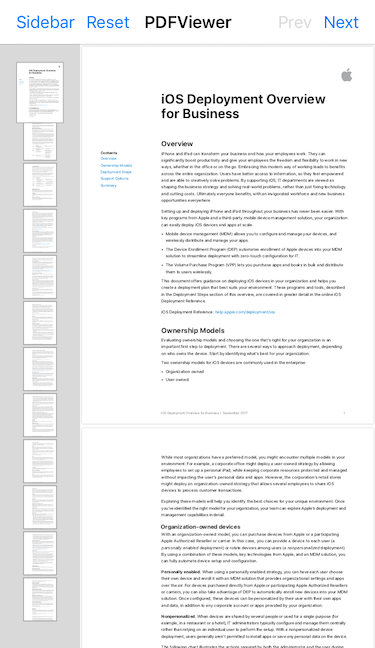
- #Pdfkit example swift how to#
- #Pdfkit example swift pdf#
- #Pdfkit example swift code#
- #Pdfkit example swift download#
#Pdfkit example swift code#
See demo source code and build script Use webpack. There are three ways to use PDFKit in the browser: Use Browserify. For more, see the demo folder and the PDFKit programming guide.
#Pdfkit example swift pdf#
Let urlSession = URLSession(configuration. The PDF output from this example (with a few additions) shows the power of PDFKit producing complex documents with a very small amount of code. First we will write the code for downloading the file. And that is just a miniature example of all the features your app can adopt with the powerful. This task contains the following topics here.įor achieving all these we have to write some code below. With PDFKit all is done with native code in a matter of minutes.
#Pdfkit example swift download#
In this tutorial, I have cover Download and store a file in iOS. So that, other person also can take the benefit of this. I thought to write a tutorial and make a video and share with YouTube. legate self pdfView.document document Implement a Custom Subclass Create a custom subclass for your custom graphics, one that will include your drawing. Getting ready Let's create a new SwiftUI app in Xcode called PDFReaderApp. This delegate will allow you to specify a method for building PDF annotations or PDF pages.

As you can imagine, PDFKit is based on UIKit however, in this recipe, we'll see how easy it is to integrate it with SwiftUI. Now we just need to connect the two views together so that changing one also changes the other: thumbnailView.pdfView = pdfViewįinally, create a URL pointing to a PDF you have in your bundle somewhere (or one in your documents directory), then create a PDFDocument object from that and pass it to the PDF view: guard let path = ’ve been working on an App that requires me to download PDF files, store it, and to view it. Since iOS 11, Apple has provided PDFKit, a robust framework to display and manipulate PDF documents in your applications. PDFThumbnailView has a few interesting properties to set, of which the most important are the size of the thumbnails and the direction they should be born: thumbnailView.thumbnailSize = CGSize(width: 100, height: 100)

We need the PDF view and PDF thumbnail view to share the space, so we’re going to make the limit the thumbnail to 120 points of height, with the PDF view taking up the rest of the space: (equalTo: thumbnailView.topAnchor).isActive = true anslatesAutoresizingMaskIntoConstraints = false A PDFOutline object is an element in a tree-structured hierarchy that can represent the structure of a PDF. PDFPage, a subclass of NSObject, defines methods used to render PDF pages and work with annotations, text, and selections. Third, create a PDFThumbnailView and pin to the bottom, left, and right edges of your view controller: let thumbnailView = PDFThumbnailView() An object that represents PDF data or a PDF file and defines methods for writing, searching, and selecting PDF data. Next, add this code to your viewDidLoad() method to create a PDFView and make it pin to the top, left, and right edges of your view: let pdfView = PDFView() There are few simple UIKit methods for that.

To try it out, start by importing the PDFKit framework: import PDFKit In case you need to create a new PDF file on iOS device you won’t actually need to use PDFKit at all. However, using it takes a little extra work because it doesn’t read PDF directly – you first load the PDF into a PDFView, then connect that to the thumbnail view.

#Pdfkit example swift how to#
How to show PDF thumbnails using PDFThumbnailViewĪpple’s PDFKit framework provides a huge range of code to help us work with PDFs, including a dedicated view for rendering thumbnails of PDF pages: PDFThumbnailView. PDFKit comes with a built-in class called PDFDocument, which allows us to load and parse PDF documents.


 0 kommentar(er)
0 kommentar(er)
